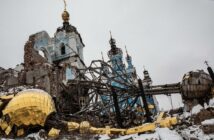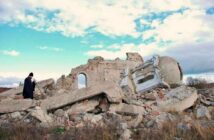Source: Daily Beast
How a priceless Russian icon—said to be painted by St. Luke himself—evaded the Bolsheviks and the Nazis to land in a charming Chicago church designed by a world-famous architect.
The Tikhvin Icon has traveled through history and across the globe on an arduous journey few pieces of art can claim to match.
A portrait of the Virgin Mother said to be painted by the divine hand of St. Luke himself, the icon is one of the world’s most precious religious objects. According to legend, over the centuries it eluded capture by the Turks, the Swedes, the Bolsheviks, and the Nazis. For the last half of the 20th century, it has been sheltered in the unassuming rectory of a charming Russian Revival church in Chicago designed by Louis Sullivan, the first distinctly American architect, the father of the skyscraper, and Frank Lloyd Wright’s mentor.
In the 1940s, after leaving its home in the Tikhvin Monastery near St. Petersburg and escaping both the Nazis and the Bolsheviks, the icon was brought to Chicago by its safekeeper, Bishop John Garklavs. There it sat in this little church designed by a world-famous architect, largely unnoticed by the world at large, for decades. In 2004 when Russia was deemed safe again, the sacred object was returned to its home in the Tikhvin Monastery.
I confess that I did not go looking for the icon. It was Sullivan’s name that originally drew me to the Windy City’s charming and leafy Ukrainian Village: how did an architect famous for buildings on a grand scale come to design the architectural curiosity called Holy Trinity Cathedral. But as I was guided around the church by its youthful pastor, Father Alexander, I quickly realized that I’d stumbled into a story even more convoluted and baroque than one of Sullivan’s architectural ornaments. Here was a tale that involved not just a world famous architect but also a tsar, a martyr, and a priceless piece of art.
By 1900, when Louis Sullivan submitted his final design for the church on the corner of Leavitt and Haddon, he was one of the most famous architects in the world. The man who coined the phrase “form follows function” was famous for his solid yet elegant steel high-rises around the country—the Wainwright in St. Louis, Guaranty in Buffalo, Bayard in New York City, and the Chicago Stock Exchange. He was at the heart of a magnificent thread of American architectural genius. He got his start in the office of Frank Furness (Pennsylvania Academy of Fine Arts), and was mentored by Richard Morris Hunt (Met facade, various Newport mansions). It was in the firm that Sullivan ran with Dankmar Adler that a young Frank Lloyd Wright rose to the position of head draughtsman (until his off-the-books residential projects forced his departure).
Sullivan, who would later put his ideas for architecture down in his The Autobiography of an Idea, spent a lifetime looking for an architecture that was uniquely American, and thus was constantly at odds with his Beaux-Arts contemporaries. He firmly believed in Vitruvius’ rule that architecture must be solid, useful, and beautiful. The beauty in his buildings often came in the form of elaborate decorative elements, usually found on entrances, windows, and eaves, the most notable example being the Carson, Pirie, Scott and Company Building and the remnants of the Chicago Stock Exchange, which can be seen at the Art Institute of Chicago.
The panic of 1893 caused his partnership with Adler to dissolve, but the 1890s were possibly his best decade, which has made his acceptance of such a small commission as Trinity Church, and for a building type that was so out of his wheelhouse, so curious. One of the reasons was undoubtedly due to the influence of industrialist, Sullivan patron, and Russophile Charles Crane, who was in contact with the church’s ambitious young pastor, Father John Kochurov.
Just 24-years-old when he was sent to the U.S. in 1895, Father John quickly set about getting a church for his growing community of Orthodox believers (mainly Slavs from the Austro-Hungarian Empire). Presented with a design by Sullivan that would eventually cost roughly $30,000 to complete, this resourceful priest managed to get $4,000 from Tsar Nicholas II himself, and raised an additional $15,000 in Russia.
Other Orthodox churches in the U.S. were built in over-the-top styles of Moscow’s cathedrals or the Russian Revival style popularized by Ivan Ropet—these buildings were, according to architectural critic Theodore Turak, “not so much Russo-Byzantine as high Victorian, being composed of an incredibly complex pile of irrelevant motifs.”
Sullivan, however, proposed something more radical.
Likely influenced by the drawings of Viollet le Duc from his travels in Russia, Sullivan designed a church in the vernacular style familiar to Russian and Ukrainian peasants. It was a cleaner, simpler look (therefore more economical), but it also allowed Sullivan to draw attention to his iconic flourishes.
The cornerstone was laid on March 31, 1902, and the structure was completed and consecrated on March 25, 1903. (The decoration would not be completed until 1911). While the church was already notable for having the involvement of a tsar and a starchitect, two other men present at the consecration would enshrine this little church’s outsized role in history.
One of those was the man who did the consecrating, Bishop Tikhon. Just four years after the ceremony, he returned to Russia where he rapidly climbed the ecclesiastical ranks until, just days after the Bolsheviks seized St. Petersburg, he was named the first Patriarch of Moscow since Peter the Great abolished the position nearly three centuries prior. After playing along with the Bolsheviks (whether in a conciliatory effort to save the church, or for less noble reasons) the Patriarch died, leaving many believers—including those who put together the church’s official History of Holy Trinity Russian Orthodox Cathedral of Chicago, 1892-1992—convinced that he was poisoned by the communists. He became a martyr-saint.
The second person whose life would take a notably dire turn was the charismatic pastor himself, Father John. Unable to stay long enough to see the decoration completed, the priest returned to Russia in 1907. Just a decade later, in 1917, he was shot by Bolsheviks and became, in the words of Bishop Theophilus of Chicago, “the first priest-martyr of that terrible conflict.”
But the effect of Sullivan’s church is a far cry from such somber notes. The building is almost playful, its white stucco walls contrasting with an octagonal dome with chevrons on the eaves. Windows with pointed detailing introduce an almost Gothic flair, and the elaborate carving on the door is pure Sullivan.
Sadly, the building was meant to be even more fetching, with a polychromatic color scheme and intricate stenciling on the outside. (Additionally, some of the signature Sullivan elements have gone missing, such as the elaborate railings on part of the tower and some of the metal roofing on the entrance canopy.)
The interior is even more splendid. Stenciled patterns designed by Sullivan employee Louis Millet fill the interior of the octagon-within-a-square church. The layout is Byzantine as opposed to Western (circular versus longitudinal). Eyes are drawn to the white and gold iconostas that Sullivan and church patron Henry Crane and International Harvester’s Harold McCormick ordered from Russia. The circular design also gives one the sense of being warmly enveloped in a colorful frenzy of stenciled designs, oval-faced Orthodox saints, and angels.
Millet also designed the church’s real showstopper—its multi-colored glass central chandelier and matching stained glass windows. The chandelier is particularly dramatic when illuminated against the blue-green ceiling filled with gold stars.
But perched in a corner on a stand is an icon covered in thoroughly polished golden riza.
“Oh, and that’s a copy of the Tikhvin Icon,” Father Alex tells me, an aside that belies both the importance of this work of art and this little church’s role in it.
The original icon, housed in the church rectory and brought out for special ceremonies until 2006, is one of the most important objects in the Russian Orthodox religion. According to legend, it was one of a number of icons claimed to have been painted by St. Luke of gospel-writing fame. For those not familiar with his non-literary oeuvre, it turns out there are not only quite a lot of paintings whose owners claim St. Luke painted them, but there’s a rich history behind the whole saga.
“The earliest reliable reference to Luke as an artist is by Andrew of Crete around 660 to 740,” explains Felicity Harley-McGowan, a specialist in early Christian and medieval art at Yale. “He wrote a treatise on the veneration of icons.”
At the time Andrew wrote his treatise, a debate was raging in Christianity about the proper role of images in worship, particularly images depicting Jesus Christ.
“He’s both divine and human,” says Harley-McGowan, pinpointing the crux of the debate. “Therefore, is it even appropriate to have a material depiction of a divinity? And if you’re going to depict a divinity, is it okay to pay homage to it?” And so, given all of this, Harley-McGowan says, it’s understandable to be skeptical about its authenticity.
There had been reports of portraits of Christ from his lifetime. The most notable (and completely shocking to me) was the legend of one painted by Pontius Pilate himself on the night Jesus was crucified.
“Luke seems to be the figure that is deemed the most appropriate and popular,” the professor goes on. The story goes that after Christ died, the Virgin Mother sat for a portrait by Luke, who depicts her holding up the ideal image of the Christ child, emphasizing that Mary was the Theotokus (God-bearer), which was at the center of another theological debate. In essence, if Saint Luke did it, it must be OK.
Luke’s portrait of Mary made its way to Constantinople in the 5th centurywhere a monastery was built to house it. (I could not find why it journeyed there.) Then, in 1383, Russian fishermen saw a light appear in the sky and followed it until they reached the icon floating over the lake near Tikhvin. Over the years, the icon would be credited with repelling foreign invaders, including the Swedes and the Poles. In 1547 the future czar Ivan visited it and ordered a monastery built to house it.
In the 20th century, just when you think the story would get less murky and surrounded in myth, it gets even more confusing. According to some accounts, the icon was first removed from the monastery in 1917 to protect it from the Bolsheviks. Others, including the aforementioned history published by the cathedral, claim that while the monastery was shut down by the Bolsheviks, the icon was not removed until the arrival of the Nazis (then the issue becomes whether the Nazis took it, or Russians moved it to hide it). Regardless, it ends up in Riga, under the watch of Bishop John Garklavs and a group of nuns. When the Germans retreated in 1944, they took the icon with them, but then abandoned it during a bombing of Liepaja, where it was scooped up again by Garklavs. According to the Chicago Tribune, saving the icon really began to pay off:
“When Latvia fell to the Soviets, the bishop and a dozen other clergy fled. With them was Sergei Garklavs, an altar boy who later was adopted by the bishop. The teenager hauled the icon—which weighs 80 pounds and measures 34 by 43 inches—on each leg of the journey.
On that journey, he says, he was introduced to the icon’s saving grace. From war-torn Latvia and Germany to Poland and Czechoslovakia, Garklavs and his companions averted danger. He recalls watching aboard a boat leaving Latvia as Soviet warplanes dropped bombs on all sides of them but never sank the ship.”
The bishop arrived in the U.S. in 1949, and brought the priceless piece with him to Holy Trinity. There it sat, safe from the godless Soviets and largely unnoticed by the American public, until 2004. Finally, Russia was under the aegis of a ruler, Vladimir Putin, who was seen as a protector of the Orthodox faith. It was safe for the icon to return.
But since then, relations between the U.S. and Russia have deteriorated to the point where many Americans likely worry they would be unwelcome (or hacked) if they went to Russia. Luckily, on this picturesque corner in the most American of the big cities and by the hand of one of the most American of the great architects, they can get a taste of Russia.



